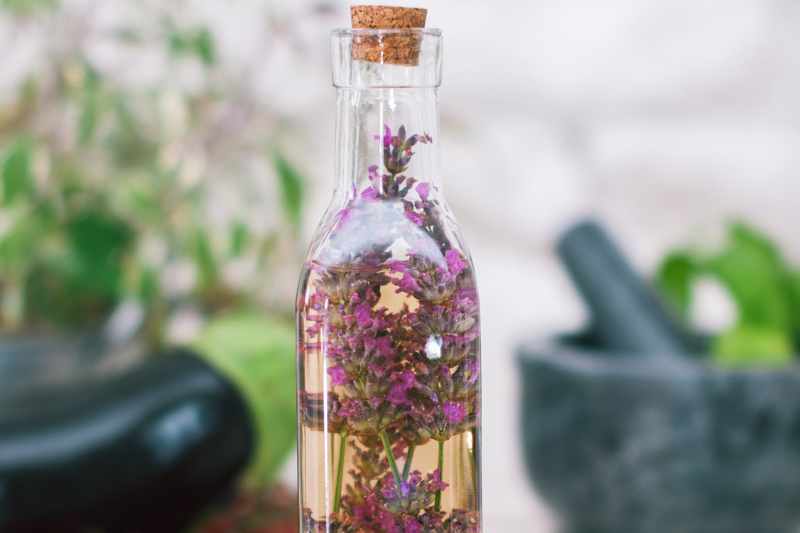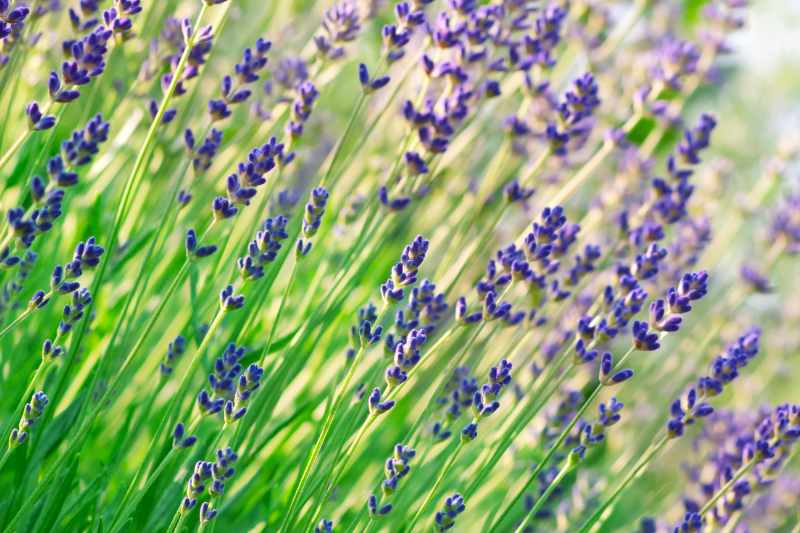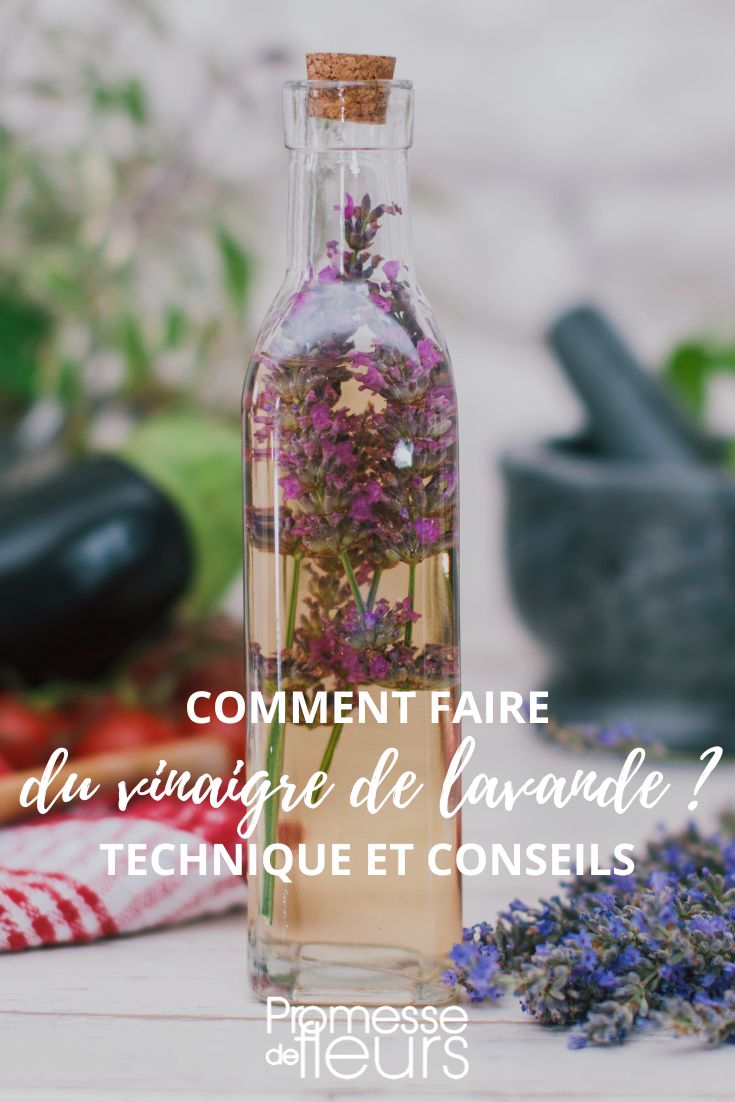With its unique and so characteristic aromatic scent, lavender fills the garden. It is also a plant of a thousand virtues, renowned for calming and antiseptic properties that can be concentrated in a vinegar to enjoy its heady scent and all its benefits! Totally natural, good for skin as well as for household care, lavender vinegar can be easily made from dried lavender spikes. Discover how to prepare homemade lavender vinegar with wonderful scent of Provence!

Which lavender variety to choose?
Choice of lavender variety is crucial for preparing vinegar. Lavandula angustifolia (true lavender or English lavender) should be favoured because it is best suited for powerful scent and therapeutic virtues. It is ideal for making quality vinegar. It comes in many varieties with different forms and colours — deep blue spikes, white flowers or pink flowers. Among them:
- Lavandula angustifolia 'Munstead' : a small lavender with very fragrant bluish-violet flower spikes. This variety forms a pretty, very rounded shrub.
- Lavandula angustifolia 'Silbermöwe' : a very low variety with silvery foliage covered all summer with compact white spikes with a fine, fresh scent.
- Lavandula angustifolia 'Hidcote' has aromatic green-silver foliage and abundant summer flowering in very fragrant bluish-violet spikes.
- Lavandula angustifolia 'Arctic Snow' forms a true ball of light with short, very pure white spikes. Its summer flowering gives off a divine scent.
- Lavandula angustifolia 'Essence Purple' stands out for long flowering from June to August and powerful yet very fine scent of its purplish-blue spikes.
- Lavandula angustifolia 'Rosea' is notable for its fragrant pink-lilac flowers and very compact habit.
- Lavandula angustifolia 'Siesta' is the tallest of the true lavenders with dark flowers, reaching stems up to 80 cm high.

When and how to harvest lavender?
Lavender is harvested during flowering, from late June to August depending on region. Peak scent intensity occurs just before flowers are fully open. For a successful harvest, choose well-flowered stems and harvest in dry weather, ideally in the morning. With clean pruning shears, cut stems close to foliage without touching wood.
How to make lavender vinegar?
Fresh lavender or dried lavender?
Two options! For this recipe, you can use dried lavender sprigs or freshly cut lavender. With dried lavender, scent will be more intense and preserves better. This also allows making lavender vinegar year-round! However, vinegar can also be prepared with freshly cut lavender stems, producing a slightly different scent.
→ Discover our article: "How to dry lavender"

For preparing lavender vinegar, you will need:
Ingredients:
- 1 large bouquet of true lavender (about 10 to 15 branches of lavender)
- 1 litre organic cider vinegar or white wine vinegar
Equipment:
- A large sterilised glass jar or large glass bottle with airtight lid
- A fine sieve or a coffee filter
- A large saucepan
- A funnel
Recipe:
- Start by sterilising bottle or glass jar to ensure good preservation. To do this, immerse container in a saucepan of boiling water for 10 minutes, remove bottles and lids with clean tongs to avoid touching with hands, then let air-dry upside down on a clean cloth
- If using fresh lavender, shake stems well after picking to remove any insects
- Rinse lavender stems under cold water (if fresh)
- Place stems at bottom of glass jar
- Using a funnel, pour vinegar to cover stems completely, leaving a small space at top of bottle to allow proper sealing
- Then close with airtight lid. Make sure cap is tight to prevent air entering.
- Keep out of light for 2 to 3 weeks. This is time needed for vinegar to absorb lavender scent
- After this period, strain vinegar using sieve or coffee filter
- Label
- Vinegar is ready to use
My tip: Don’t hesitate to make several bottles at once, for yourself or as gifts!

Storing lavender vinegar
To store lavender vinegar, choose a glass bottle, preferably dark, with an airtight lid. Lavender vinegar, like most vinegars, keeps very well. After opening, if kept away from light and heat in a cool, dry place (for example in a kitchen cupboard), it can last several months, even up to a year. However, lavender flavour and aroma may fade over time. To enjoy maximum flavour, it is recommended to use within six months of opening.
Uses for lavender vinegar
Lavender vinegar proves to be a multi-purpose product. In cooking, it brings an original aromatic note to vinaigrettes, marinades and even some desserts. In cosmetics, it is a genuine wellness and beauty ally and can be used as a skin tonic, soothing in compresses on insect bites, or on sunburn to calm itching, as a rinse for hair, relaxing in a purifying bath and helpful against lice or acne thanks to lavender virtues. It is also used as an ecological, scented cleaning product for home and as a scented fabric softener for laundry.
To go further
- Lavender: planting, to grow and pruning
- How to fail at lavender in 5 lessons?
- Lavender: which to choose?
- How to propagate lavender?
- Healthy, strong hair thanks to plants from your garden































Comments